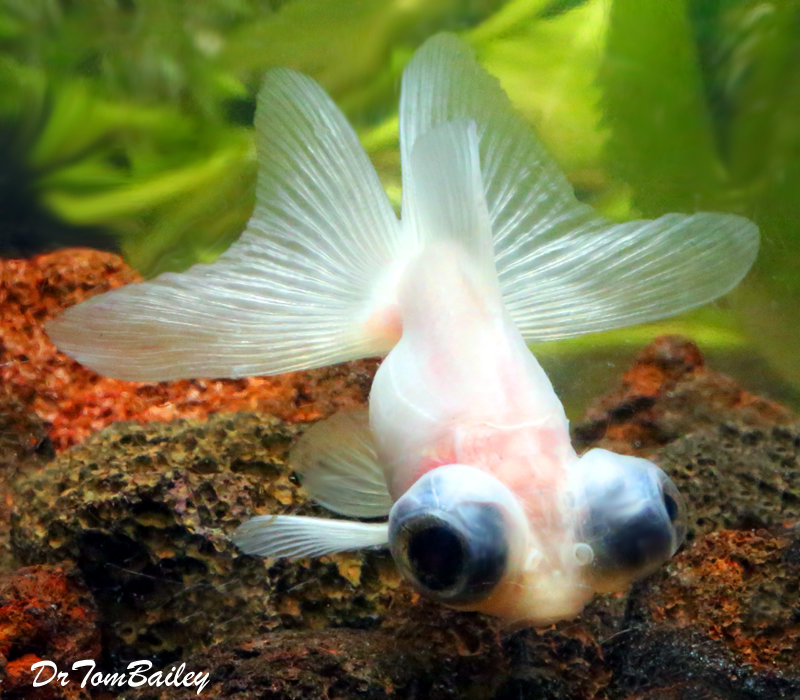
May get larger when kept in healthy conditions. Common Name Telescope Eye Goldfish Scientific Name Carassius Auratus Family Cyprinidae Average Size 6 to 8 inches at maturity. They need plenty of space as this will ensure their healthy growth.Īs far as diet goes, the Telescopes are omnivorous, and they should have the right mix of plant-based food and meaty ones. Long tanks are ideal for these as these fish enjoy the extended surface area and keep the fish well oxygenated. These are cold-water fish and can survive the winter months even if you keep them in your pond. Just make sure that the water conditions are ideal for its healthy growth. These can be kept in any environment that is aesthetically pleasing to you. They come in various colors such as red, blue, chocolate brown, calico, bi-color, red and white, or black and white.

The Telescope Eye goldfish is one of the most popular variety fancy goldfish, and they have a rounded, egg-shaped body with caudal fins and a flowing broad tail. Avoid slow-moving goldfish for tank mates Ideal Water Temperature 65 ☏ to 75 ☏ pH level 6 to 8 3. Common Name Shubunkin Goldfish/ Calico Goldfish Scientific Name Carassius Auratus Family Cyprinidae Average Size 10 to 12 inches at maturity Average Lifespan 10 to 15 years Behavior Fast swimmers Habitat Coldwater aquariums/ ponds Minimum Tank Capacity 10 to 15 gallons for each adult Feeding Habits Omnivorous Tank Mates Other similar-sized goldfish. These type are excellent community fish and will make a great addition to your tank of fast-moving breeds. You can feed them a mix of fresh, frozen, or pellets twice a day. Shubunkins are omnivorous so they will enjoy a good variety of plant-based and meaty food items. If you intend to keep the Shubunkins in your ponds, then do add some form of shade as they do fade out with too much exposure to direct sunlight. These breeds are quite active, so they need a spacious tank to swim about and explore. However, all these have similar body shapes with several color variations ranging from black, blue, white, orange, or red. The Shubunkins come in three different types – the Japanese, the Bristol, and the London. These fish are sturdy and can easily tolerate the cold months even without a heater, making them beautiful species for ponds or fish tanks. The Shubunkin goldfish has long flowing fins and blue color patches, adding a colorful flair to your tank. Common Name Comet Goldfish Scientific Name Carassius Auratus Family Cyprinidae Average Size 10 to 12 inches at maturity Average Lifespan Can live up to 14 years of age in ideal conditions Behavior Fast swimmers Habitat Coldwater aquariums/ponds Minimum Tank Capacity 50 Gallons Feeding Habits Omnivorous Tank Mates Other similar-sized goldfish Ideal Water Temperature 50 ☏ to 75 ☏ pH level 6.5 to 7.5 2.

The water’s ideal temperature should be between 50 ☏ to 75 ☏ with pH levels ranging from 6.5 to 7.5.Ĭomets do not make very good tank mates, so keep similar-sized fish in your tanks, such as the Shubunkin or the Jikin. Fifty gallons to 75 gallons capacity tank would be ideal for your comet to thrive.Īnother vital thing to keep in mind is that this breed prefers cold water so remember not to keep the tank near any direct heat source. Comets can grow to the size of the common goldfish, and therefore, the tank in which they are kept has to be of the appropriate size. These might injure the tails of the comet as they swim.Ĭomets come in orange, red, white, yellow, or white with orange coloration.

The Comets like space as they highly active hence keepers need to be careful not to crowd the tank with too many ornaments. The Comet goldfish is one of the most popular species with a lean body with a distinctive widespread tail with sharp tips. So, whichever type of goldfish you choose, keep in mind the tank setup specifications and maintenance. However, if they do not get adequate sunlight, they can turn completely white.

They are born brown but grow into the well-known orange hue with age. Interesting Fact: Goldfish is that they can change color depending on their exposure to light.


 0 kommentar(er)
0 kommentar(er)
